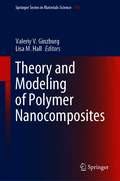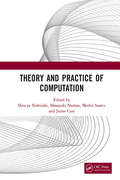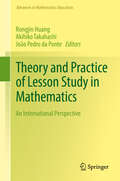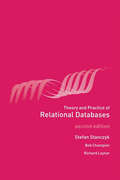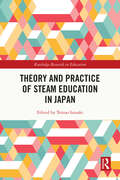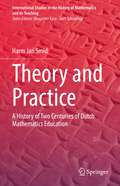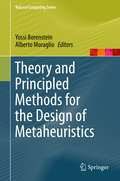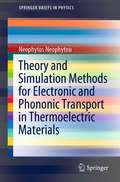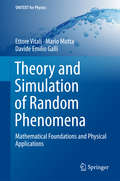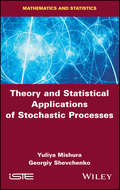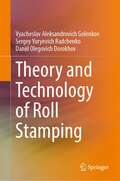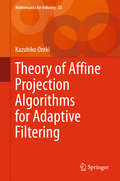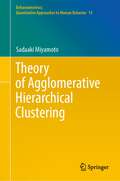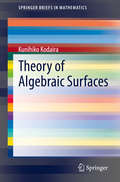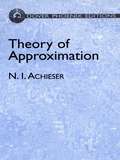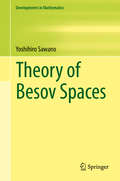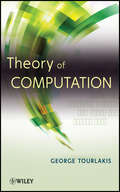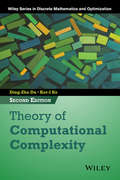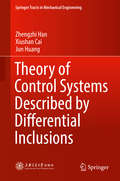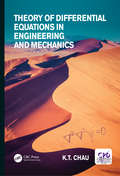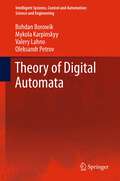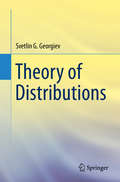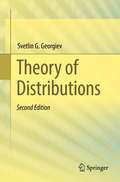- Table View
- List View
Theory and Modeling of Polymer Nanocomposites (Springer Series in Materials Science #310)
by Valeriy V. Ginzburg Lisa M. HallThis edited volume brings together the state of the art in polymer nanocomposite theory and modeling, creating a roadmap for scientists and engineers seeking to design new advanced materials. The book opens with a review of molecular and mesoscale models predicting equilibrium and non-equilibrium nanoscale structure of hybrid materials as a function of composition and, especially, filler types. Subsequent chapters cover the methods and analyses used for describing the dynamics of nanocomposites and their mechanical and physical properties. Dedicated chapters present best practices for predicting materials properties of practical interest, including thermal and electrical conductivity, optical properties, barrier properties, and flammability. Each chapter is written by leading academic and industrial scientists working in each respective sub-field. The overview of modeling methodology combined with detailed examples of property predictions for specific systems will make this book useful for academic and industrial practitioners alike.
Theory and Practice of Computation: Proceedings of the Workshop on Computation: Theory and Practice (WCTP 2019), September 26-27, 2019, Manila, The Philippines
by Shin-Ya NishizakiThis book provides a collection of papers from the Ninth Workshop on Computing: Theory and Practice, WCTP 2019 devoted to theoretical and practical approaches to computation, which was organized by four top universities in Japan and the Philippines: Tokyo Institute of Technology, Osaka University, the University of the Philippines Diliman, and De La Salle University. The proceedings provide a broad overview of recent research trends in computer science research in Asia, particularly in these two countries. The papers included in the proceedings focus on both theoretical and practical aspects of computations, such as programming language theory, modeling of software systems, applications of machine learning, empathic computing, and various applications of information technology.
Theory and Practice of Lesson Study in Mathematics: An International Perspective (Advances in Mathematics Education)
by Rongjin Huang João Pedro da Ponte Akihiko TakahashiThis book brings together and builds on the current research efforts on adaptation, conceptualization, and theorization of Lesson Study (LS). It synthesizes and illustrates major perspectives for theorizing LS and enriches the conceptualization of LS by interpreting the activity as it is used in Japan and China from historical and cultural perspectives. Presenting the practices and theories of LS with practicing teachers and prospective teachers in more than 10 countries, it enables the reader to take a comparative perspective. Finally, the book presents and discusses studies on key aspects of LS such as lesson planning, post-lesson discussion, guiding theories, connection between research and practice, and upscaling.Lesson Study, which has originated in Asia as a powerful effective professional development model, has spread globally. Although the positive effects of lesson study on teacher learning, student learning, and curriculum reforms have been widely documented, conceptualization of and research on LS have just begun to emerge. This book, including 38 chapters contributed by 90 scholars from 21 countries, presents a truly international collaboration on research on and adaptation of LS, and significantly advances the development of knowledge about this process.Chapter 15: "How Variance and Invariance Can Inform Teachers’ Enactment of Mathematics Lessons" of this book is available open access under a CC BY 4.0 license at link.springer.comTheory and Practice of Lesson Study in Mathematics: An International Perspective shows that the power of Lesson Study to transform the role of teachers in classroom research cannot be explained by a simple replication model. Here we see Lesson Study being successful internationally when its key principles and practices are taken seriously and are adapted to meet local issues and challenges. (Max Stephens, Senior research fellow at The University of Melbourne)It works. Instruction improves, learning improves. Wide scale? Enduring? Deep impact? Lesson study has it. When something works as well as lesson study does, while alternative systems for improving instruction fail, or only succeed on small scale or evaporate as quickly as they show promise, it is time to understand how and why lesson study works. This volume brings the research on lesson study together from around the world. Here is what we already know and here is the way forward for research and practice informed by research. It is time to wake up and pay attention to what has worked so well, on wide scale for so long.(Phil Dara, A leading author of the Common Core State Standards of Mathematics in the U.S.)
Theory and Practice of Relational Databases
by Bob Champion Stefan Stanczyk Richard LeytonThe study of relationship databases is a core component of virtually every undergraduate computer science degree course. This new edition of Theory and Practice of Relationship Databases retains all the features that made the previous edition such as success, and goes on to give even more comprehensive and informative coverage.Written in a tutorial style and containing a great many examples and exercises as well as extensively using illustrative and explanatory graphics, the author has produced an undergraduate textbook of great depth and clarity that is very easy to follow. The subject of relational databases is brought to life by the writing style and the inclusion of an homogenous case study that reinforces the issues dealt with in each chapter.The primary objective of the book is to present a comprehensive explanation of the process of development of database application systems within the framework of a set processing paradigm. Since the majority of these applications are built as relationship systems, a complete though reasonably concise account of that model is presented. Dr. Stanczyk has achieved this by concentrating on the issues that contribute significantly to the application development while de-emphasizing purely theoretical aspects of the subject. This has led to an imaginative and highly practical textbook that will be an excellent read for the undergraduate computer science student.
Theory and Practice of STEAM Education in Japan (Routledge Research in Education)
by Tetsuo IsozakiWith unique insights into the potential power of Japan’s STEM education, Isozaki and his team of contributors share multiple perspectives on STEM education theory and practices in Japan.Examining how Japan has become an economic superpower based on scientific and technological innovations, this book provides a particular focus on the theoretical and practical analysis of STEM education from historical and comparative perspectives. Additionally, it links the theory and practice of STEM education from primary education to teacher education at universities across Japan and considers both societal and individual needs in advancing STEM literacy. Chapters are written by researchers from a diverse range of fields in education, including science, mathematics, technology, and pedagogy. The book also offers practical teaching tools and materials for teacher education and assessment to promote STEM literacy in students so that they are able to address local and global socio-scientific issues in a real-world context.Covering a wide spectrum of STEM education, this book provides valuable insights and practical suggestions, from a Japanese perspective, for academic researchers, policymakers, and educators who are interested in STEM education.
Theory and Practice: A History of Two Centuries of Dutch Mathematics Education (International Studies in the History of Mathematics and its Teaching)
by Harm Jan SmidThis book describes and analyses the history of Dutch mathematics education from the point of view of the changing motivations behind the teaching of mathematics over a 200 year period. During the course of the 19th century, mathematics in the Netherlands developed from a topic for practitioners into a school topic that was taught to almost all pupils of secondary education. As mathematics teaching gradually lost its practical orientation and became more and more motivated on the basis of its supposed formative value, the HBS (Hogere Burgerschool), the Dutch variant of the German Realschule, became the dominant school of thought for mathematics pedagogy. This book examines the gradual development of the field, culminating in the country-wide adoption of Realistic Mathematics Education as the new method of mathematics teaching. This book is important for anyone who is interested in the history of mathematics education. It provides an interesting perspective on the development of mathematics education in a country that, in many aspects, went its own way.
Theory and Principled Methods for the Design of Metaheuristics
by Yossi Borenstein Alberto MoraglioMetaheuristics, and evolutionary algorithms in particular, are known to provide efficient, adaptable solutions for many real-world problems, but the often informal way in which they are defined and applied has led to misconceptions, and even successful applications are sometimes the outcome of trial and error. Ideally, theoretical studies should explain when and why metaheuristics work, but the challenge is huge: mathematical analysis requires significant effort even for simple scenarios and real-life problems are usually quite complex. In this book the editors establish a bridge between theory and practice, presenting principled methods that incorporate problem knowledge in evolutionary algorithms and other metaheuristics. The book consists of 11 chapters dealing with the following topics: theoretical results that show what is not possible, an assessment of unsuccessful lines of empirical research; methods for rigorously defining the appropriate scope of problems while acknowledging the compromise between the class of problems to which a search algorithm is applied and its overall expected performance; the top-down principled design of search algorithms, in particular showing that it is possible to design algorithms that are provably good for some rigorously defined classes; and, finally, principled practice, that is reasoned and systematic approaches to setting up experiments, metaheuristic adaptation to specific problems, and setting parameters. With contributions by some of the leading researchers in this domain, this book will be of significant value to scientists, practitioners, and graduate students in the areas of evolutionary computing, metaheuristics, and computational intelligence.
Theory and Simulation Methods for Electronic and Phononic Transport in Thermoelectric Materials (SpringerBriefs in Physics)
by Neophytos NeophytouThis book introduces readers to state-of-the-art theoretical and simulation techniques for determining transport in complex band structure materials and nanostructured-geometry materials, linking the techniques developed by the electronic transport community to the materials science community. Starting from the semi-classical Boltzmann Transport Equation method for complex band structure materials, then moving on to Monte Carlo and fully quantum mechanical models for nanostructured materials, the book addresses the theory and computational complexities of each method, as well as their advantages and capabilities. Presented in language that is accessible to junior computational scientists, while including enough detail and depth with regards to numerical implementation to tackle modern research problems, it offers a valuable resource for computational scientists and postgraduate researchers whose work involves the theory and simulation of electro-thermal transport in advanced materials.
Theory and Simulation in Physics for Materials Applications: Cutting-Edge Techniques in Theoretical and Computational Materials Science (Springer Series in Materials Science #296)
by Elena V. Levchenko Yannick J. Dappe Guido OriThis book provides a unique and comprehensive overview of the latest advances, challenges and accomplishments in the rapidly growing field of theoretical and computational materials science. Today, an increasing number of industrial communities rely more and more on advanced atomic-scale methods to obtain reliable predictions of materials properties, complement qualitative experimental analyses and circumvent experimental difficulties. The book examines some of the latest and most advanced simulation techniques currently available, as well as up-to-date theoretical approaches adopted by a selected panel of twelve international research teams. It covers a wide range of novel and advanced materials, exploring their structural, elastic, optical, mass and electronic transport properties. The cutting-edge techniques presented appeal to physicists, applied mathematicians and engineers interested in advanced simulation methods in materials science. The book can also be used as additional literature for undergraduate and postgraduate students with majors in physics, chemistry, applied mathematics and engineering.
Theory and Simulation of Random Phenomena: Mathematical Foundations and Physical Applications (UNITEXT for Physics)
by Ettore Vitali Mario Motta Davide Emilio GalliThe purpose of this book is twofold: first, it sets out to equip the reader with a sound understanding of the foundations of probability theory and stochastic processes, offering step-by-step guidance from basic probability theory to advanced topics, such as stochastic differential equations, which typically are presented in textbooks that require a very strong mathematical background. Second, while leading the reader on this journey, it aims to impart the knowledge needed in order to develop algorithms that simulate realistic physical systems. Connections with several fields of pure and applied physics, from quantum mechanics to econophysics, are provided. Furthermore, the inclusion of fully solved exercises will enable the reader to learn quickly and to explore topics not covered in the main text. The book will appeal especially to graduate students wishing to learn how to simulate physical systems and to deepen their knowledge of the mathematical framework, which has very deep connections with modern quantum field theory.
Theory and Statistical Applications of Stochastic Processes
by Yuliya Mishura Georgiy ShevchenkoThis book is concerned with the theory of stochastic processes and the theoretical aspects of statistics for stochastic processes. It combines classic topics such as construction of stochastic processes, associated filtrations, processes with independent increments, Gaussian processes, martingales, Markov properties, continuity and related properties of trajectories with contemporary subjects: integration with respect to Gaussian processes, Itȏ integration, stochastic analysis, stochastic differential equations, fractional Brownian motion and parameter estimation in diffusion models.
Theory and Synthesis of Linear Passive Time-Invariant Networks
by Dante C. YoulaExploring the overlap of mathematics and engineering network synthesis, this book presents a rigorous treatment of the key principles underpinning linear lumped passive time-invariant networks. Based around a series of lectures given by the author, this thoughtfully written book draws on his wide experience in the field, carefully revealing the essential mathematical structure of network synthesis problems. Topics covered include passive n-ports, broadband matching, the design of passive multiplexes and two-state passive devices. It also includes material not usually found in existing texts, such as the theoretical behavior of transverse electromagnetic (TEM) coupled transmission lines. Introducing fundamental principles in a formal theorem-proof style, illustrated by worked examples, this book is an invaluable resource for graduate students studying linear networks and circuit design, academic researchers, and professional circuit engineers.
Theory and Technology of Roll Stamping
by Vyacheslav Aleksandrovich Golenkov Sergey Yuryevich Radchenko Daniil Olegovich DorokhovThis book gives a complete overview of the roll stamping process of metal forming. This fundamentally new technique features an integrated local loading of the plastic deformation zone of the workpiece, simultaneously combining the die forging operation and local deformation of the deformation zone by rotating rollers or drive rolls. The book presents the basics of the theory behind roll stamping, delivering a complete technical analysis including the key results of mathematical modeling studies and a discussion of methodologies for designing novel roll stamping techniques. The aim of the new metal forming processes proposed in the book is directed toward the production of competitive equipment for fabrication of various mechanical parts having enhanced materials and physical properties in combination with a low cost of production and maintenance. This book is an ideal resource for any student or practicing engineer working with the roll stamping process.
Theory of Affine Projection Algorithms for Adaptive Filtering
by Kazuhiko OzekiThis book focuses on theoretical aspects of the affine projection algorithm (APA) for adaptive filtering. The APA is a natural generalization of the classical, normalized least-mean-squares (NLMS) algorithm. The book first explains how the APA evolved from the NLMS algorithm, where an affine projection view is emphasized. By looking at those adaptation algorithms from such a geometrical point of view, we can find many of the important properties of the APA, e. g. , the improvement of the convergence rate over the NLMS algorithm especially for correlated input signals. After the birth of the APA in the mid-1980s, similar algorithms were put forward by other researchers independently from different perspectives. This book shows that they are variants of the APA, forming a family of APAs. Then it surveys research on the convergence behavior of the APA, where statistical analyses play important roles. It also reviews developments of techniques to reduce the computational complexity of the APA, which are important for real-time processing. It covers a recent study on the kernel APA, which extends the APA so that it is applicable to identification of not only linear systems but also nonlinear systems. The last chapter gives an overview of current topics on variable parameter APAs. The book is self-contained, and is suitable for graduate students and researchers who are interested in advanced theory of adaptive filtering.
Theory of Agglomerative Hierarchical Clustering (Behaviormetrics: Quantitative Approaches to Human Behavior #15)
by Sadaaki MiyamotoThis book discusses recent theoretical developments in agglomerative hierarchical clustering. The general understanding of agglomerative hierarchical clustering is that its theory was completed long ago and there is no room for further methodological studies, at least in its fundamental structure. This book has been planned counter to that view: it will show that there are possibilities for further theoretical studies and they will be not only for methodological interests but also for usefulness in real applications. When compared with traditional textbooks, the present book has several notable features. First, standard linkage methods and agglomerative procedure are described by a general algorithm in which dendrogram output is expressed by a recursive subprogram. That subprogram describes an abstract tree structure, which is used for a two-stage linkage method for a greater number of objects. A fundamental theorem for single linkage using a fuzzy graph is proved, which uncovers several theoretical features of single linkage. Other theoretical properties such as dendrogram reversals are discussed. New methods using positive-definite kernels are considered, and some properties of the Ward method using kernels are studied. Overall, theoretical features are discussed, but the results are useful as well for application-oriented users of agglomerative clustering.
Theory of Algebraic Surfaces (SpringerBriefs in Mathematics)
by Kunihiko KodairaThis is an English translation of the book in Japanese, published as the volume 20 in the series of Seminar Notes from The University of Tokyo that grew out of a course of lectures by Professor Kunihiko Kodaira in 1967. It serves as an almost self-contained introduction to the theory of complex algebraic surfaces, including concise proofs of Gorenstein's theorem for curves on a surface and Noether's formula for the arithmetic genus. It also discusses the behavior of the pluri-canonical maps of surfaces of general type as a practical application of the general theory. The book is aimed at graduate students and also at anyone interested in algebraic surfaces, and readers are expected to have only a basic knowledge of complex manifolds as a prerequisite.
Theory of Approximation (Dover Books on Mathematics)
by N. I. AchieserA pioneer of many modern developments in approximation theory, N. I. Achieser designed this graduate-level text from the standpoint of functional analysis. The first two chapters address approximation problems in linear normalized spaces and the ideas of P. L. Tchebysheff. Chapter III examines the elements of harmonic analysis, and Chapter IV, integral transcendental functions of the exponential type. The final two chapters explore the best harmonic approximation of functions and Wiener's theorem on approximation. Professor Achieser concludes this exemplary text with an extensive section of problems and applications (elementary extremal problems, Szego's theorem, the Carathéodory-Fejér problem, and more).
Theory of Besov Spaces (Developments in Mathematics #56)
by Yoshihiro SawanoThis is a self-contained textbook of the theory of Besov spaces and Triebel–Lizorkin spaces oriented toward applications to partial differential equations and problems of harmonic analysis. These include a priori estimates of elliptic differential equations, the T1 theorem, pseudo-differential operators, the generator of semi-group and spaces on domains, and the Kato problem. Various function spaces are introduced to overcome the shortcomings of Besov spaces and Triebel–Lizorkin spaces as well. The only prior knowledge required of readers is familiarity with integration theory and some elementary functional analysis.Illustrations are included to show the complicated way in which spaces are defined. Owing to that complexity, many definitions are required. The necessary terminology is provided at the outset, and the theory of distributions, L^p spaces, the Hardy–Littlewood maximal operator, and the singular integral operators are called upon. One of the highlights is that the proof of the Sobolev embedding theorem is extremely simple. There are two types for each function space: a homogeneous one and an inhomogeneous one. The theory of function spaces, which readers usually learn in a standard course, can be readily applied to the inhomogeneous one. However, that theory is not sufficient for a homogeneous space; it needs to be reinforced with some knowledge of the theory of distributions. This topic, however subtle, is also covered within this volume. Additionally, related function spaces—Hardy spaces, bounded mean oscillation spaces, and Hölder continuous spaces—are defined and discussed, and it is shown that they are special cases of Besov spaces and Triebel–Lizorkin spaces.
Theory of Computation
by George TourlakisLearn the skills and acquire the intuition to assess the theoretical limitations of computer programming Offering an accessible approach to the topic, Theory of Computation focuses on the metatheory of computing and the theoretical boundaries between what various computational models can do and not do--from the most general model, the URM (Unbounded Register Machines), to the finite automaton. A wealth of programming-like examples and easy-to-follow explanations build the general theory gradually, which guides readers through the modeling and mathematical analysis of computational phenomena and provides insights on what makes things tick and also what restrains the ability of computational processes. Recognizing the importance of acquired practical experience, the book begins with the metatheory of general purpose computer programs, using URMs as a straightforward, technology-independent model of modern high-level programming languages while also exploring the restrictions of the URM language. Once readers gain an understanding of computability theory--including the primitive recursive functions--the author presents automata and languages, covering the regular and context-free languages as well as the machines that recognize these languages. Several advanced topics such as reducibilities, the recursion theorem, complexity theory, and Cook's theorem are also discussed. Features of the book include: A review of basic discrete mathematics, covering logic and induction while omitting specialized combinatorial topics A thorough development of the modeling and mathematical analysis of computational phenomena, providing a solid foundation of un-computability The connection between un-computability and un-provability: Gödel's first incompleteness theorem The book provides numerous examples of specific URMs as well as other programming languages including Loop Programs, FA (Deterministic Finite Automata), NFA (Nondeterministic Finite Automata), and PDA (Pushdown Automata). Exercises at the end of each chapter allow readers to test their comprehension of the presented material, and an extensive bibliography suggests resources for further study. Assuming only a basic understanding of general computer programming and discrete mathematics, Theory of Computation serves as a valuable book for courses on theory of computation at the upper-undergraduate level. The book also serves as an excellent resource for programmers and computing professionals wishing to understand the theoretical limitations of their craft.
Theory of Computational Complexity
by Ding-Zhu Du Ker-I KoPraise for the First Edition "...complete, up-to-date coverage of computational complexity theory...the book promises to become the standard reference on computational complexity." -Zentralblatt MATH A thorough revision based on advances in the field of computational complexity and readers' feedback, the Second Edition of Theory of Computational Complexity presents updates to the principles and applications essential to understanding modern computational complexity theory. The new edition continues to serve as a comprehensive resource on the use of software and computational approaches for solving algorithmic problems and the related difficulties that can be encountered. Maintaining extensive and detailed coverage, Theory of Computational Complexity, Second Edition, examines the theory and methods behind complexity theory, such as computational models, decision tree complexity, circuit complexity, and probabilistic complexity. The Second Edition also features recent developments on areas such as NP-completeness theory, as well as: A new combinatorial proof of the PCP theorem based on the notion of expander graphs, a research area in the field of computer science Additional exercises at varying levels of difficulty to further test comprehension of the presented material End-of-chapter literature reviews that summarize each topic and offer additional sources for further study Theory of Computational Complexity, Second Edition, is an excellent textbook for courses on computational theory and complexity at the graduate level. The book is also a useful reference for practitioners in the fields of computer science, engineering, and mathematics who utilize state-of-the-art software and computational methods to conduct research. A thorough revision based on advances in the field of computational complexity and readers' feedback, the Second Edition of Theory of Computational Complexity presents updates to the principles and applications essential to understanding modern computational complexity theory. The new edition continues to serve as a comprehensive resource on the use of software and computational approaches for solving algorithmic problems and the related difficulties that can be encountered. Maintaining extensive and detailed coverage, Theory of Computational Complexity, Second Edition, examines the theory and methods behind complexity theory, such as computational models, decision tree complexity, circuit complexity, and probabilistic complexity. The Second Edition also features recent devnd complexity at the graduate level. The book is also a useful reference for practitioners in the fields of computer science, engineering, and mathematics who utilize state-of-the-art software and computational methods to conduct research.
Theory of Control Systems Described by Differential Inclusions
by Zhengzhi Han Xiushan Cai Jun HuangThis book provides a brief introduction to the theory of finitedimensional differential inclusions, and deals in depth with control of threekinds of differential inclusion systems. The authors introduce the algebraicdecomposition of convex processes, the stabilization of polytopic systems, andobservations of Luré systems. They also introduce the elemental theory offinite dimensional differential inclusions, and the properties and designs ofthe control systems described by differential inclusions. Addressing thematerial with clarity and simplicity, the book includes recent researchachievements and spans all concepts, concluding with a critical mathematicalframework. This book is intended for researchers, teachers and postgraduatestudents in the area of automatic control engineering.
Theory of Differential Equations in Engineering and Mechanics
by Kam Tim ChauThis gives comprehensive coverage of the essential differential equations students they are likely to encounter in solving engineering and mechanics problems across the field -- alongside a more advance volume on applications. This first volume covers a very broad range of theories related to solving differential equations, mathematical preliminaries, ODE (n-th order and system of 1st order ODE in matrix form), PDE (1st order, 2nd, and higher order including wave, diffusion, potential, biharmonic equations and more). Plus more advanced topics such as Green’s function method, integral and integro-differential equations, asymptotic expansion and perturbation, calculus of variations, variational and related methods, finite difference and numerical methods. All readers who are concerned with and interested in engineering mechanics problems, climate change, and nanotechnology will find topics covered in these books providing valuable information and mathematics background for their multi-disciplinary research and education.
Theory of Digital Automata
by Oleksandr Petrov Mykola Karpinskyy Bohdan Borowik Valery LahnoThis book serves a dual purpose: firstly to combine the treatment of circuits and digital electronics, and secondly, to establish a strong connection with the contemporary world of digital systems. The need for this approach arises from the observation that introducing digital electronics through a course in traditional circuit analysis is fast becoming obsolete. Our world has gone digital. Automata theory helps with the design of digital circuits such as parts of computers, telephone systems and control systems. A complete perspective is emphasized, because even the most elegant computer architecture will not function without adequate supporting circuits. The focus is on explaining the real-world implementation of complete digital systems. In doing so, the reader is prepared to immediately begin design and implementation work. This work serves as a bridge to take readers from the theoretical world to the everyday design world where solutions must be complete to be successful.
Theory of Distributions
by Svetlin G. GeorgievThis book explains many fundamental ideas on the theory of distributions. The theory of partial differential equations is one of the synthetic branches of analysis that combines ideas and methods from different fields of mathematics, ranging from functional analysis and harmonic analysis to differential geometry and topology. This presents specific difficulties to those studying this field. This book, which consists of 10 chapters, is suitable for upper undergraduate/graduate students and mathematicians seeking an accessible introduction to some aspects of the theory of distributions. It can also be used for one-semester course.
Theory of Distributions
by Svetlin G. GeorgievThis book explains many fundamental ideas on the theory of distributions. The theory of partial differential equations is one of the synthetic branches of analysis that combines ideas and methods from different fields of mathematics, ranging from functional analysis and harmonic analysis to differential geometry and topology. This presents specific difficulties to those studying this field. This second edition, which consists of 10 chapters, is suitable for upper undergraduate/graduate students and mathematicians seeking an accessible introduction to some aspects of the theory of distributions. It can also be used for one-semester course.
